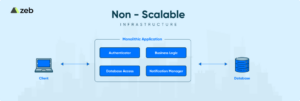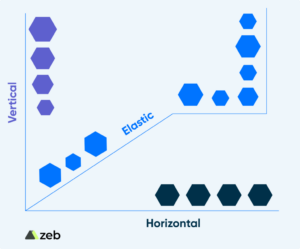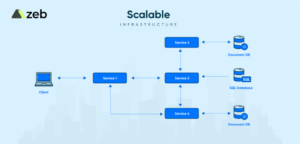Organizations strive for booming expansion, generally with the objective of not just progress, but continued growth. Consequently, businesses must have the ability to scale their infrastructure in order to achieve rapid expansion. When an enterprise drags scalability to the future, it risks creating a legacy system that will be challenging to upgrade and manage in the years ahead.
Hence, it is essential to embrace scalability from the start.
As stated by Cloud Native Development, Kubernetes has seen significant growth over the last 12 months, with 5.6 million professionals using it worldwide. This marks a 67% rise from the previous year.
Demonstrated beyond doubt, the assurance of scalability is an important factor in Kubernetes’ swift uptake.
1. Link-ArrowCommon Pitfalls of Non-Scalable Infrastructure
2. Link-ArrowHorizontal vs Vertical vs Elastic Scaling
3. Link-ArrowHow Kubernetes Resolves Non-Scalability
Common Pitfalls of Non-Scalable Infrastructure
Enterprises that do not scale become highly susceptible to several performance bottlenecks. While some may miss the mark of lowering the time necessary to make alterations, others may not be able to reduce time-to-market.
Below we have discussed the most prominent repercussions that businesses face due to their inability to scale:

Challenging Deployments
- While you may begin with one deployment per month, that number will undoubtedly surge as your company grows.
- This leads to higher attrition, or system problems, such as scripts failing or deployments demanding a long time to complete.
Single Point of Failure
- Monolithic systems are engineered to grow up instead of out.
- Thus, you can only remedy a problem by adding additional hardware. You can’t add a new server because they all execute the same program, resulting in a single point of failure.
- A single point of failure contributes to performance problems, outages, and sluggish flow rates.
Higher Cost & Time
- As your business grows, your infrastructure will get more complex.
- The more intricate your infrastructure becomes; the more modifications will be required.
- All of this elevates the costs while diverting time and attention far from your application.
Horizontal vs Vertical vs Elastic Scaling
Kubernetes provides several features to assist in making applications scalable and fault tolerant. Its potential to calibrate each and every element in your infrastructure comes as a bonus in terms of scalability.
There are three types of scalabilities offered by Kubernetes. Each comes with its own set of advantages:

- Horizontal scaling or scaling out entails adding to your infrastructure to meet increased demand.
- Vertical scaling or scaling up is the inclusion of new assets into a system in order to meet the increasing demands. It aims to increase the power of existing equipment.
- Elastic scaling entails upgrading the cluster seamlessly and flexibly to accommodate fluctuating demand spikes. When demand is low, resources that are no longer required are reallocated. During moments of intense demand, additional resources are assigned to match the work overload.
Kubernetes can effortlessly and proficiently perform all three.
How Kubernetes Resolves Non-Scalability
Now that we have covered the types of scalabilities K8s offers, let’s see how it comprehensively eliminates non-scalability from your infrastructure, thereby resolving the pitfalls we highlighted earlier.
It does it predominantly by adding flexibility to your infrastructure, making it more adaptable to shift. It also lowers expenses and raises quality to levels that would be difficult to accomplish otherwise.

Maximum Uptime
Kubernetes was engineered with scalability as its priority. As a result, one of its significant advantages is its capacity to self-heal.
If an application component fails, Kubernetes will immediately relaunch it in the intended or desired state.
Ultimately, there is no room for downtime when Kubernetes is in place.
Defined and Efficient System
Being multifaceted, Kubernetes has the ability to build a functional system that includes replication, autoscaling, and service resolution.
This offloads the entanglements that take place between developers and operations. It also provides developers autonomy while reducing operational expenses.
High-Availability
Kubernetes enhances dependability by delivering repeating elements. This allows application containers to be scheduled across several nodes and availability zones in the cloud.
As per the labeling, node selection will enable you to choose which nodes in your cluster are qualified to run your application.
Move on from Non-Scalability with Us
Allow our Kubernetes solution to inaugurate a brand-new phase for your company!
Keep up with the demands of modern software development and achieve scalability in no time. We are dedicated to following industry best practices and standards. Our experts will thoroughly examine your organization’s requirements in order to provide a safe, resilient, and versatile Kubernetes solution.
Ready for a Kubernetes solution that is self-sufficient and unrestricted?